Many people know about environmental art. Andy Goldsworthy made the concept public and popular from the Eighties onwards. More recently land artists such as Richard Shilling and James Brunt provide child-friendly inspiration through their inspirational art work.
Some of the most beautiful environmental art I’ve seen undertaken at various workshops has been facilitated by facilitated by Alan Kain. He is a very popular furniture maker, school grounds consultant, Forest School practitioner, designer, artist and all round good guy. Not surprisingly he is heavily in demand from schools, the play sector and other organisations who book him for training, working with children to create bespoke school grounds features and other contracts.
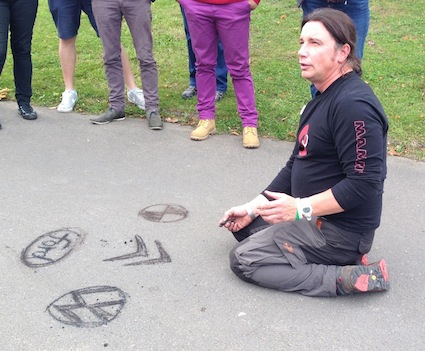
Several years ago, I was privileged to invite Alan to do a workshop on something that could be done in any outdoor space. So we worked on the tarmac on a dead end road. As Alan pointed out, tarmac does have its uses, not least as a very durable surface and great background for some Autumn leaf art.

Rather than complicated instructions, Alan gave several useful tips such as using nylon-free clay to stick the leaves down and not trying to create a picture but to consider the colour, pattern or line of the work. He also used the opportunities of using leaves as a way of helping the participants learn more about leaves, trees, their value and properties. As the photos show, he manages to bring out the artist within each and every person and group. It was a spot-on workshop.
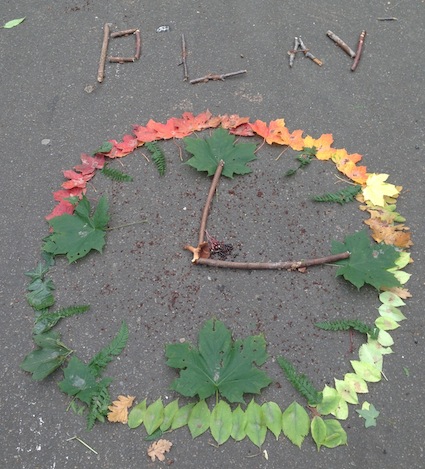
Nylon-free and pvc-free clay should be used to avoid fine plastic fibres ending up in the environment. You can buy this via Muddy Faces who have clear descriptions about which of their clays have what type of additives.
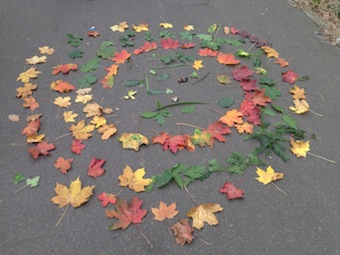
Just by viewing these photos, lots of possibilities spring to mind. Enjoy the tone and colour of this carefully constructed flag. Definitely time to wave the natural flag and think about the beauty and benefits of nature…
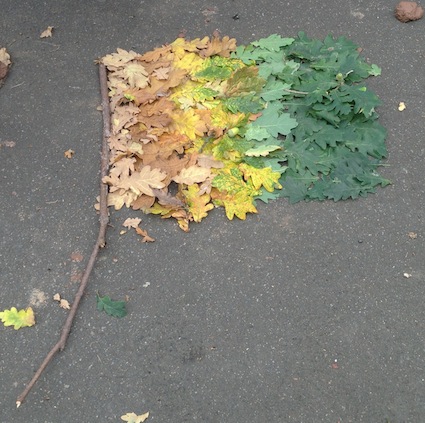
Why not explore the mathematical properties through a symmetrical butterfly?…

Imagine meeting a spider this size! Not the norm in Scotland…
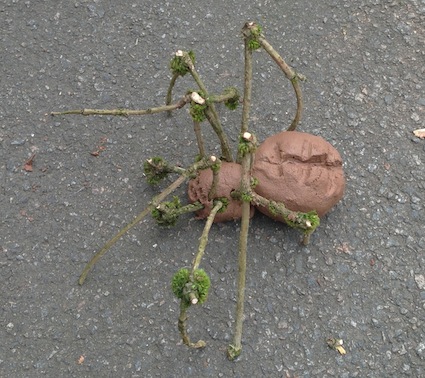
I’m wondering what sort of mini beast the creature below could be…
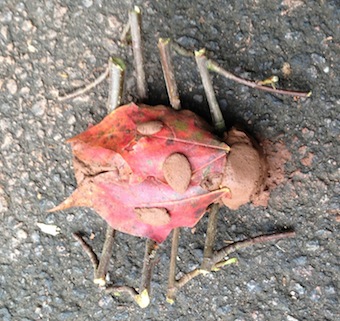
The tortoise was rather hungry and even tried to chomp on a dead leaf…

The wee mouse was rather tempted by the parcel of cheese…

And check out the moral of this photo. The hedgehog on the left has yet to cross the road. The one on the right was flattened. Oh dear!

The work each group made was wonderful. What do you think? What would you do with some autumn leaves?
Finally, I think a lovely apt quote comes from Sir Patrick Geddes (1854-1932), a Scottish town planner, biologist and educator. “By leaves we live. Some people have strange ideas that they live by money. They think energy is generated by the circulation of coins. Whereas the world is mainly a vast leaf colony, growing on and forming a leafy soil, not by a mere mineral mass; and we live not by the jingling of our coins but by the fullness of our harvests. Moreover, the leaves made the coal: coal is but plant-life fossilised; and hence the coal miners are the modern masters of energy.” (Geddes, P. (1919). Final lecture at Dundee University (published in a 1949 reprint of Cities in Evolution). London:Williams and Norgate).
Many thanks to Inspiring Scotland and its Go2Play programme for funding this training day. The video below is taken from a Learning through Landscapes Scotland Conference workshop which Alan facilitated back in 2011 but remains an inspirational watch.
This blog post is an update of one that first appeared in September 2013.




















Oh those photos are gorgeous, will share the post tomorrow. Think the leaf flag is my favourite xx
Thanks Kierna
Love this idea. We need to collect some leaves up but they’re not changing here yet. Last year we made a collage on paper, but I like the idea of doing it on the pavement or patio maybe. #CountryKids
Oh you must live in a warmer part of the country. Our maple leaves are beginning to change and others are quickly following. Enjoy the last of the summer.
I think the ideas are endless! This would really inspire children’s creativity and is such fun. The photos of the art you created are fab and the clay idea for keeping the leaves in place is a handy tip. Thanks for linking up and sharing your fun outdoor play idea with Country Kids.
Hello Fiona – you are welcome. It’s always good to have a look and see what others have posted too.
what a wonderful opportunity to experience nature and art together. I love the flag, thats my favourite, but they are all beautiful creations. popping over from coombemill
Thanks! I will go and check your blog!
What a great idea! The minibeasts are my favourite!
Thanks for your response! It’s interesting how everyone seems to prefer a different photo or idea! I’m for the labyrinth, many have mentioned the flag, others like the beasties. I guess we should just give children the choice and flexibility to come up with their own ideas and designs!
Thanks for everything you share with us Juliette. I hope to use the above ideas with my nursery on Wed next week and then with my church Sunday Club on an outing with their mums ave dads next Sat at Dunham Massey.
That’s lovely to hear – thanks Julie. Really the credit goes to Alan Kain who is extremely creative and talented and allowed me to photograph and blog about his workshop.